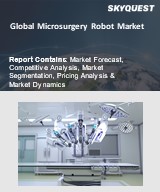
Report ID: SQMIG35G2273

Report ID:
SQMIG35G2273 |
Region:
Global |
Published Date: April, 2024
Pages:
217
|
Tables:
69 |
Figures:
72
Drivers
Advances in Surgical Technology
Increasing Demand for Less Invasive Surgeries
Increased Incidence of Cancer
Restraints
High Cost of Adoption
Regulatory Challenges and Safety Concerns
Our industry expert will work with you to provide you with customized data in a short amount of time.
REQUEST FREE CUSTOMIZATIONWant to customize this report? This report can be personalized according to your needs. Our analysts and industry experts will work directly with you to understand your requirements and provide you with customized data in a short amount of time. We offer $1000 worth of FREE customization at the time of purchase.

Report ID: SQMIG35G2273